|
|
|
|
|
|
|
|
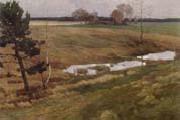 |
Walter Leistikow
|
|
1865-1908,German painter, decorative artist, etcher, exhibition organizer and writer. He studied painting briefly in 1883, at the Akademie in Berlin, but he was dismissed after six months as 'untalented'. From 1883 to 1885 he trained with the painter Hermann Eschke (1823-1900) and from 1885 to 1887 with the Norwegian painter Hans Fredrik Gude. Gude had a decisive influence on the style of Leistikow's early works, as is especially clear in Leistikow's light coastal landscapes with figures. His most significant work from this period, however, is Brickworks near Eckernferde (1887; ex-Gem?ldegal. Neue Meister, Dresden). Leistikow's dismissal from the Akademie concentrated his attention on issues of artistic policy. When the German government decided not to send works for exhibition in the Exposition Universelle in Paris in 1889, Leistikow himself organized the dispatch of works to Paris. In 1892, |
|
|
|
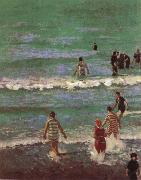 |
Walter Richard Sickert
|
|
British Camden Town Group Painter, 1860-1942
British painter, printmaker, teacher and writer of German birth. Sickert was one of the most influential British artists of this century. He is often called a painter painter, appealing primarily to artists working in the figurative tradition; there are few British figurative painters of the 20th century whose development can be adequately discussed without reference to Sickert subject-matter or innovative techniques. He had a direct influence on the Camden Town Group and the Euston Road School, while his effect on Frank Auerbach, Howard Hodgkin and Francis Bacon was less tangible. Sickert active career as an artist lasted for nearly 60 years. His output was vast. He may be judged equally as the last of the Victorian painters and as a major precursor of significant international developments in later 20th-century art, especially in his photo-based paintings. |
|
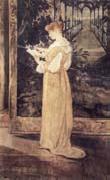 |
Walter Shirlaw
|
|
Scottish-American artist , 1838-1909
was a Scottish-American artist. Shirlaw was born in Paisley, Scotland, and moved to the United States with his parents in 1840. He worked as a bank-note engraver, and his work was first exhibited at the National Academy in 1861. He was elected an academician of the Chicago Academy of Design in 1868. Among his pupils there was Frederick Stuart Church. From 1870 to 1877 he studied in Munich, under George Raab, Richard Wagner, Arthur George von Ramberg, and Wilhelm Lindenschmidt. His first work of importance was the Toning of the Bell (1874), which was followed by Sheep-shearing in the Bavarian Highlands (1876). The latter, which is probably the best of his works, received honorable mention at the Paris exposition in 1878. Other notable works from his easel are Good Morning (1878), in the Buffalo Academy; Indian Girl and Very Old (1880); Gossip (1884); and Jealousy (1886), owned by the Academy of Design, New York. His largest work is the frieze for the dining-room in the house of Darius O. Mills in New York. Shirlaw has also earned an excellent reputation as an illustrator. He was one of the founders of the Society of American Artists, and was its first president. On his return from Europe he took charge of the Art Students League of New York, and for several years taught in the composition class. |
|
 |
Walter Sickert
|
|
German
1860-1942
Walter Sickert Gallery
Walter Richard Sickert (May 31, 1860 in Munich, Germany ?C January 22, 1942 in Bath, England) was a German-born English Impressionist painter. Sickert was a cosmopolitan and eccentric who favoured ordinary people and urban scenes as his subjects
He developed a personal version of Impressionism, favouring sombre colouration. Following Degas' advice, Sickert painted in the studio, working from drawings and memory as an escape from "the tyranny of nature".[3] Sickert's earliest major works were portrayals of scenes in London music halls, often depicted from complex and ambiguous points of view, so that the spatial relationship between the audience, performer and orchestra becomes confused, as figures gesture into space and others are reflected in mirrors. The isolated rhetorical gestures of singers and actors seem to reach out to no-one in particular, and audience members are portrayed stretching and peering to see things that lie beyond the visible space. This theme of confused or failed communication between people appears frequently in his art.
By emphasising the patterns of wallpaper and architectural decorations, Sickert created abstract decorative arabesques and flattened the three-dimensional space. His music hall pictures, like Degas' paintings of dancers and caf??-concert entertainers, connect the artificiality of art itself to the conventions of theatrical performance and painted backdrops. Many of these works were exhibited at the New English Art Club, a group of French-influenced realist artists with which Sickert was associated. At this period Sickert spent much of his time in France, especially in Dieppe where his mistress, and possibly his illegitimate son, lived |
|
 |
Walter Ufer
|
|
American Painter, 1876-1936,was an American artist based in Taos, New Mexico. His most notable work focuses on scenes of Native American life, particularly of the Pueblo Indians. Walter was born of German immigrant parents and raised in Kentucky. After an apprenticeship as a lithographer, he went to Europe where he was a traveling journeyman. When he returned to America, he worked as a printer in Chicago and taught school, and later took classes in fine arts. After a brief time in Chicago, he returned to Europe for further study as an artist. |
|
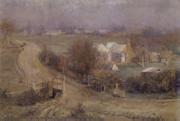 |
Walter Withers
|
|
English-born Australian Painter,
1854-1914
was an Australian landscape artist and a member of the Heidelberg School of Australian impressionists. Withers was born at Handsworth, Staffordshire, the son of Edwin Withers. He showed an early desire to paint, but objection was made to this by his father. It is not known what occupation he followed in England, but in 1882 he arrived in Australia with the intention of going on the land. After working for about 18 months on a farm, Withers removed to Melbourne and obtained a position as draughtsman in a firm of printers. He then took up his painting again, and began to exhibit with the Victorian Academy of Arts afterwards merged in the Victorian Artists' Society. In 1887 Withers went to Europe. There he was married to Miss F. Flinn and studied for some months at the Academie Julian, Paris. He returned to Australia with his wife in June 1888 having been commissioned to do black and white work for Messrs Fergusson and Mitchell of Melbourne. His most important work in this way will be found in the illustrations to Edmund Finn's, The Chronicles of Early Melbourne. Withers settled down at first at Kew, a suburb of Melbourne, and then near Heidelberg on the other side of the river Yarra. He became friendly with Arthur Streeton, Charles Conder, Tom Roberts, Frederick McCubbin and other leading artists of the period. He began to sell a few pictures, but the collapse of the land boom put an end to his illustrative work. He obtained some work as a drawing and painting master in schools, and in 1891 opened a studio in Collins-street west, where he held his first private exhibition. |
|
|
|
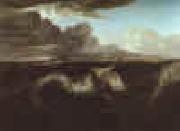 |
Washington Allston
|
|
1779-1843
Washington Allston Gallery Allston was born on a plantation on the Waccamaw River near Georgetown, South Carolina. His mother Rachel Moore had married Captain William Allston in 1775, though her husband died in 1781, shortly after the Battle of Cowpens. Moore remarried to Dr. Henry C. Flagg, the son of a wealthy shipping merchant from Newport, Rhode Island.
Allston graduated from Harvard College in 1800 and moved to Charleston, South Carolina for a short time before sailing to England in May 1801. He was admitted to the Royal Academy in London in September, when painter Benjamin West was then the president.
From 1803 to 1808 he visited the great museums of Paris and then for several years those of Italy, where he met Washington Irving in Rome, and Coleridge, his lifelong friend. In 1809 Allston married Ann Channing, sister of William Ellery Channing. Samuel F. B. Morse was one of Allston's art pupils and accompanied Allston to Europe in 1811. After traveling throughout western Europe, Allston finally settled in London, where he won fame and prizes for his pictures.
Allston was also a published writer. In London in 1813, he published The Sylphs of the Seasons, with Other Poems, republished in Boston, Massachusetts later that year. His wife died in February 1815, leaving him saddened, lonely, and homesick for America.
In 1818 he returned to the United States and lived in Cambridge, Massachusetts for 25 years. He was the uncle of the artists George Whiting Flagg and Jared Bradley Flagg, both of whom studied painting under him.
In 1841 he published Monaldi, a romance illustrating Italian life, and in 1850, a volume of his Lectures on Art, and Poems.
Allston died on July 9, 1843, at age 64. Allston is buried in Harvard Square, in "the Old Burying Ground" between the First Parish Church and Christ Church. |
|
|
|
 |
Wassilij Grigorjewitsch Perow
|
|
Vasily Grigorevich Perov (Russian; real name Vasily Grigorevich Kridener ; 2 January 1834 (21 December 1833 Old Style) - 10 June (29 May Old Style) 1882) was a Russian painter and one of the founding members of Peredvizhniki, a group of Russian realist painters.
Vasily Perov was born 2 January 1834 (21 December 1833 Old Style) in Tobolsk, being the illegitimate son of procurator, baron Grigory Karlovich Kridener. After completing a course at Arzamas uezd school, he was transferred to the Alexander Stupin art school also located in Arzamas. In 1853 he was admitted to the Moscow School of Painting, Sculpture and Architecture, where he learned from several renowned artists.
In 1856 he was awarded with a minor silver medal for his sketch of a boy's head, presented to the Imperial Academy of Arts. Later the Academy gave him many other awards: in 1857 a major silver medal for Commissary of Rural Police Investigating, a minor golden medal for the Scene on a Grave and the Son of a Dyak Promoted to First Rank, and in 1861 a major golden medal for Sermon in a Village.
After receiving the right to a state-paid trip abroad together with a golden medal, in 1862 Perov went to Western Europe, visiting several German cities, and then Paris. During this time he created paintings depicting scenes from European street life, such as the Vendor of statuettes, the Savoyard, the Organ-Grinder in Paris, the Musicians and the Bystanders, and the Paris Ragpickers.
Returning to Moscow early, from 1865 to 1871 Perov created his masterpieces The Queue at The Fountain, A Meal in the Monastery, Last Journey, Troika, the Lent Monday, Arrival of a New Governess in a Merchant House, the Drawing Teacher, A Scene at the Railroad, the Last Tavern at Town Gate, the Birdcatcher, the Fisherman, and the Hunters at Rest.
|
|
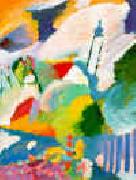 |
Wassily Kandinsky
|
|
1866-1944
Wassily Kandinsky Galleries
was a Russian painter, printmaker and art theorist. One of the most famous 20th-century artists, he is credited with painting the first modern abstract works.
Born in Moscow, Kandinsky spent his childhood in Odessa. He enrolled at the University of Moscow and chose to study law and economics. Quite successful in his profession??he was offered a professorship (chair of Roman Law) at the University of Dorpat??he started painting studies (life-drawing, sketching and anatomy) at the age of 30.
In 1896 he settled in Munich and studied first in the private school of Anton Azbe and then at the Academy of Fine Arts, Munich. He went back to Moscow in 1914 after World War I started. He was unsympathetic to the official theories on art in Moscow and returned to Germany in 1921. There he taught at the Bauhaus school of art and architecture from 1922 until the Nazis closed it in 1933. He then moved to France where he lived the rest of his life, and became a French citizen in 1939. He died at Neuilly-sur-Seine in 1944.
|
|
|
|
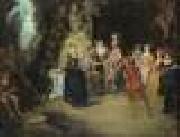 |
WATTEAU, Antoine
|
|
(1684?C1721).
French painter of Flemish descent, b. Valenciennes. Until 1704 poverty forced him to work in the shops of mediocre artists, where he produced genre and devotional subjects. In 1704?C8 he studied in the studio of Claude Gillot, an adept painter of scenes of theatrical life, which later became the subject of some of Watteau's finest paintings, such as Love in the Italian Theatre and Love in the French Theatre (both: Berlin). In 1708?C9 Watteau worked with the decorator Claude Audran. Watteau attracted the attention of eminent patrons in his last years, including the comte de Caylus, his biographer, and in 1717 he was made a full member of the Acad??mie royale. The Embarkation for Cythera (1717; Louvre) is characteristic of his art; it is a delicate, courtly fantasy, represented in warm and shimmering pastel tones that place him among the great colorists of all time. A lyric, Giorgionesque quality pervades his airy, gay, and sensuous scenes, which have a poignancy that none of his followers attained. Out of the most fleeting aspects of life he created an enduring and individual art. His exquisite paintings influenced fashion and garden design in the 18th cent. Other outstanding works include Gilles (Louvre), Perspective (Mus. of Fine Arts, Boston), Mezzetin (Metropolitan Mus.), and Gersaint's Shop Sign (1719; Berlin). |
|
 |
WATTEAU, Louis-Joseph
|
|
French Painter, 1731-1798
Nephew of Antoine Watteau. He trained in Paris with Jacques Dumont, and at the Academie Royale, where in 1751 he was awarded first prize for painting. In 1755 he settled in Lille; there he became assistant teacher at the school of drawing, but was dismissed, because of what was considered a scandalous innovation, the introduction of study of the nude, as in Paris. He then returned to Valenciennes for some 15 years; around 1770 he became assistant teacher to Louis-Jean Gueret, director of the school of drawing in Lille, whom he succeeded in the post in 1778. On Watteau's initiative, an annual Salon, at which he himself exhibited regularly, was established in Lille in 1773. |
|
|
|
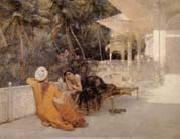 |
Weeks Lord-Edwin
|
|
189-1903
American artist, was born at Boston, Massachusetts, in 1849. He was a pupil of Leon Bonnat and of Jean-Leon Gerome, at Paris. He made many voyages to the East, and was distinguished as a painter of oriental scenes. In 1895 he wrote and illustrated a book of travels, From the Black Sea through Persia and India, and two years later he published Episodes of Mountaineering. He died in November 1903. He was a member of the Legion d'honneur, France, an officer of the Order of St. Michael, Germany, and a member of the Secession, Munich. |
|
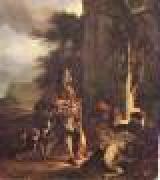 |
WEENIX, Jan
|
|
Dutch painter (b. 1642, Amsterdam, d. 1719, Amsterdam). |
|
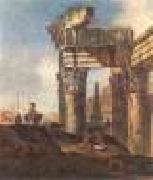 |
WEENIX, Jan Baptist
|
|
Dutch Baroque Era Painter, 1621-ca.1663
Painter and draughtsman, son of Jan Baptist Weenix. Jan probably received his first instruction as a painter from his father, and it is possible that he helped finish certain of his father's works. He probably remained in Utrecht after his father's death. By 1664 he had become a member of the Guild of St Luke in Utrecht without, however, having submitted the required entrance painting, which he provided by 1668. There are several documented references to Jan in the late 1660s. He inherited a legacy along with his uncle, the painter Barent Micker, and other family members in 1667, at which time Gillis, his younger brother, apparently still required a guardian. He received another legacy in 1668, the year of his marriage, and in 1669 served as a witness for the inventory of the painter Jacob de Hennin (1629-c. 1688) in The Hague. |
|
|
|
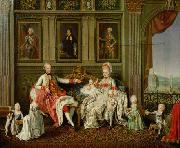 |
Wenceslaus Werlin
|
|
Wenceslaus Werlin (died 1780) was an Austrian painter.
Werlin specialized in portraits. He died in Florence in 1780.
|
|
|
|
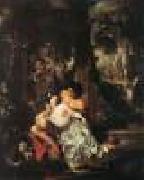 |
WERFF, Adriaen van der
|
|
Dutch Baroque Era Painter, 1659-1722
Dutch painter and draughtsman. He was apprenticed to the portrait painter Cornelis Picolet (1626-79) from 1668 to 1670 and then from c.1671 to 1676 to Eglon van der Neer in Rotterdam. From 1676 van der Werff produced small portraits and genre paintings as an independent master; the Cook and Hunter at a Window (1678; New York, priv. col.; see Gaethgens, no. 2) and Man and Woman Seated at a Table (1678; St Petersburg, Hermitage) perpetuate the thematic and stylistic traditions of Gerrit Dou, Gabriel Metsu, Frans van Mieris and Gerard ter Borch (ii) but are distinguished by their greater elegance and richness of costume and interior. Van der Werff's portraits date mainly from the years 1680-95 (e.g. Two Children with a Guinea-pig and a Kitten (1681; London, Buckingham Pal., Royal Col.)). The motif of children with animals recalls van der Neer, while the careful depiction of fabrics recalls the Leiden school of 'Fine' painters. His Portrait of a Man in a Quilted Gown (1685; London, N.G.) resembles compositions by Caspar Netscher and Nicolaes Maes: a figure leaning against a balustrade, before a landscape. Van der Werff's work is, however, more elegant, in part because of the depiction of fabrics, but also because of the inclusion for the first time of Classical sculpture, in this case the Farnese Flora |
|
|
|
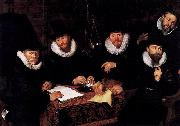 |
Werner van den Valckert
|
|
Though he was born in Amsterdam, he became a member of the Guild of St. Luke in the Hague between 1600 - 1605. By 1614 he had moved to Amsterdam, because his daughter was baptized there. His earliest dated etchings are from 1612. His surviving paintings are historical allegories and portraits. He also made a prestigious schutterstuk, which features the Amsterdam burgermeester Albert Burgh.
According to Houbraken, he was a student of Hendrik Goltzius. He painted a series of 4 paintings showing a doctor as angel, Christ, a man, and the devil; these were all based on engravings by Goltzius. These paintings are now in the possession of the Boerhaave Museum, which has other similar series on display. |
|
 |
WERTINGER, Hans
|
|
German painter (b. 1465, Landshut, d. 1533, Landshut)
German painter and woodcutter. An artist as ambitious as Lucas Cranach I, he became one of Germany's first accredited court painters, working for the Dukes of Landshut in the triangular area defined by Ingolstadt, Straubing and Munich. The son of a functionary working for the Dukes, he was probably first taught by a certain Sigmund Gleism?ller (c. 1449-1511). Hans Mair (Mair von Landshut), who had come from Augsburg and had settled in Landshut, seems to have prompted him to work as a journeyman in Augsburg. His acquisition of citizen's rights in Landshut in 1491 suggests he was a master by that date. Mair seemingly procured him a series of commissions between 1497 and 1499 from Prince Bishop Philipp of Freising (1480-1541). The only work to survive from this period, however, is the large panel of the Life of St Sigismund (1498) in Freising Cathedral. It retains the deep tones associated with Augsburg painting, and its shape, with a pointed arch at the top, must also have been developed in Augsburg. As in Mair's work, several scenes are assembled in the arch and the side sections, creating a cramped Late Gothic framing architecture, |
|
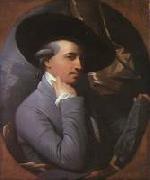 |
WEST, Benjamin
|
|
American Neoclassical Painter, 1738-1820
American historical painter who worked in England. He was born in Springfield, Pa., in a house that is now a memorial museum at Swarthmore College. After some instruction from a local artist named William Williams, he set up as a portrait painter in Philadelphia at 18, subsequently moving to New York City. In 1760 he went to Europe, where he remained for the rest of his life. For three years he studied in Italy. Working under the tutelage of Anton Mengs, he was also inspired by the classical research of Johann Winckelmann. He then settled in London, becoming a leader of the neoclassical movement. Under the patronage of George III, commissions came to him in great numbers, and in 1772 he was appointed historical painter to the king. A founder of the Royal Academy, he succeeded Sir Joshua Reynolds as its president in 1792. West executed more than 400 canvases, chiefly historical, mythological, and religious subjects painted on a heroic scale. He had many pupils and was a generous friend and adviser to younger artists, particularly American painters studying in England, among whom were Washington Allston, Samuel Morse, Charles Willson Peale, Gilbert Stuart, and John Singleton Copley. His influence on American painting of the period was predominant. Among West's best-known works are Death of General Wolfe (Grosvenor Gall., London) and Penn's Treaty with the Indians (Pa. Acad. of the Fine Arts). In these paintings he created a new departure in historical painting by clothing his figures in the costume of their period instead of the traditional classical garb. |
|
 |
WET, Gerrit de
|
|
Dutch painter, Amsterdam school (c. 1616 - 1674, Leyden)
|
|
|
|
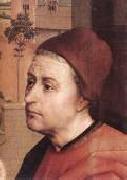 |
WEYDEN, Rogier van der
|
|
Netherlandish Northern Renaissance Painter, ca.1400-1464
major early Flemish master, known also as Roger de la Pasture. He is believed to have studied with Robert Campin. His early works also show the influence of Jan van Eyck. Van Eyck, however, had been a master at objective rendering of detail, whereas Roger in his work portrayed emotions with an assurance that has not been surpassed. His ability to depict piety is reflected in the early masterpiece Descent from the Cross (c.1435; Prado); he depicted with significant restraint the profound grief of the mourners grouped around the tragic figure of Jesus. His composition strongly affected later representations of the theme. Roger became City Painter in Brussels in 1436. He then produced a series of undated altarpieces including the Last Judgment (hospital, Beaune), the Braque Triptych (Louvre), Crucifixion with Donors (Vienna), and Adoration of the Magi (Berlin), which vary in execution from a stress on sumptuous details to a more sculptural rendering of the figures. Roger is believed to have made a pilgrimage to Italy in the holy year 1450. Whether this supposed excursion had any effect on his style is much debated. It has been shown that his Entombment (Uffizi) bears an affinity to the Tuscan treatment of the subject, particularly by Fra Angelico, and that Roger's Virgin and Child with Saints (Frankfurt) has a strong resemblance to the Italian religious art of the day. His style is, however, highly individual. His religious paintings and his portraits are characterized by a straightforward monumentality. The portraits, such as that of a young lady (National Gall. of Art, Washington, D.C.) and of Francesco d'Este (Metropolitan Mus.) exhibit a simple clarity of contour and psychological penetration. Other notable works are his St. Luke Painting the Virgin, of which a version or replica is in the Museum of Fine Arts, Boston, the Crucifixion |
|
 |
WIERINGEN, Cornelis Claesz van
|
|
Dutch painter (b. ca. 1580, Haarlem, d. 1633, Haarlem)
Dutch draughtsman, painter, etcher and navigator. His name first appears in the Haarlem records in 1597. It is generally assumed that he was a pupil of Hendrick Vroom, whose work strongly influenced his own. Documentary sources confirm that he maintained close friendships with both Hendrick Goltzius, who made woodcuts after his drawings (see fig.), and Cornelis Cornelisz. van Haarlem. Van Wieringen was more than once governor of the Haarlem Guild of St Luke, a position in which he was responsible for updating the guild's outmoded organization. He specialized in seascapes and received commissions from the city of Haarlem, the Dutch Admiralty in Amsterdam and others. His interest lies primarily in his influence on Dutch marine painters of the 17th century. |
|
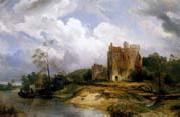 |
Wijnand Nuyen
|
|
Dutch Painter, 1813-1839, Dutch painter and printmaker who specialised in landscapes, and was greatly influenced by the French Romantics. Born to a baker father who recognised his son's talent, Nuijen was apprenticed at age twelve to Andreas Schelfhout in Den Haag. Between 1825 and 1829 he studied at the Den Haag Tekenacademie, under Bartholomeus Johannes van Hove. In his short lifespan Nuijen turned into a prolific painter of rural and marine landscapes, spending much time on the Normandy and northern French coasts. Here he fell under the spell of painters who were working in France, such as Richard Parkes Bonington (1802-1828) and Eugene Isabey (1803-1886), both of whom painted picturesque villages, Normandy harbours and seascapes, with a spontaneity Nuijen admired and adopted. His preoccupation with ruins is typically Romantic and his use of colour and texture is reminiscent of the watercolours of Turner. The Felix Meritis society of Amsterdam awarded him a medal in 1829 for his watercolour of a forest landscape. On completion of his tuition he travelled to Belgium, France and Germany, at times with his painting companion Antonie Waldorp [1803-1866]. Nuijen became a member of the Koninklijke Akademie in Amsterdam in 1836, and just before his death he married the daughter of Schelfhout, his former tutor. Nuijen was unusual among Dutch painters of the period, his theatricality and liberal style contrasting with the near photographic depiction that was then the norm. King William II greatly admired Nuijen's work and bought the "Shipwreck" in 1843, |
|
 |
WILDENS, Jan
|
|
Flemish Baroque Era Painter, 1586-1653
Flemish painter and draughtsman, active also in Italy. He was an important and proficient landscape painter who worked with Rubens and other masters in Antwerp. |
|
|
|
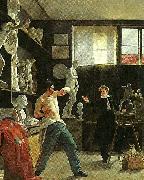 |
wilhelm bendz
|
|
(March 20, 1804 ?C November 14, 1832), Danish genre and portrait painter, is one of the main personages associated with the Golden |
|
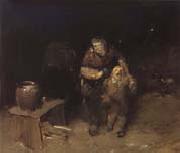 |
Wilhelm Busch
|
|
1832 Wiedensahl/Hannover-1908,was a German caricaturist, painter and poet who is known for his satirical picture stories. After studying first mechanical engineering and then art in Dusseldorf, Antwerpen and Munich, he turned to drawing caricatures. One of his first picture stories, Max and Moritz (published in 1865), was a huge success. Max and Moritz as well as many of his other picture stories are regarded as one of the main precursors of the modern comic strip. Max and Moritz, for instance, has been an inspiration for the Katzenjammer Kids. Wilhelm Busch also wrote a number of poems in a similar style to his picture stories. Besides that he produced more than 1,000 oil paintings that weren't sold before his death in 1908. He was also active as a sculptor. |
|
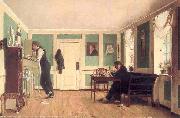 |
Wilhelm Ferdinand Bendz
|
|
(March 20, 1804 - November 14, 1832), Danish genre and portrait painter, is one of the main personages associated with the Golden Age of Danish Painting. He was educated at the Royal Danish Academy of Art (Det Kongelige Danske Kunstakademi) in Copenhagen from 1820 to 1825, winning both silver medals but never the gold prize. He studied under professor Christoffer Wilhelm Eckersberg, but may at the same time have acquired some knowledge of contemporary German painting.
Today he is mainly remembered for his many technically accomplished portraits, though his ambition most of all ran towards a refined fusion of portrait, genre scene and allegorical history painting. His technical virtuosity is particularly visible in his depictions of the play of light cast from an obscured source and the resulting shadows. During his travel to Italy - which also brought him a one-year stay in Munich - he caught a sickness to the lungs and died at the age of 28 in 1832. |
|
|
|
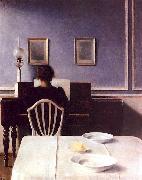 |
Wilhelm Hammershoi
|
|
Danish 1864-1916
The son of a well-to-do merchant, Christian Hammershøi and his wife, Frederikke (n??e Rentzmann), Vilhelm studied drawing from the age of eight with Neils Christian Kierkegaard and Holger Grønvold, as well as painting with Vilhelm Kyhn, before embarking on studies with Frederik Vermehren and others at the Royal Danish Academy of Fine Arts. From 1883 to 1885, he studied with Peder Severin Krøyer at the Independent Study Schools, then debuted in the Charlottenborg Exhibition in the spring of 1885 with Portrait of a Young Girl (his sister, Anna; Pierre Auguste Renoir is reported to have admired this painting). Hammershøi married Ida Ilsted in 1891. |
|
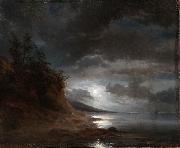 |
Wilhelm Krause
|
|
Wilhelm Krause (July 12, 1833 - February 4, 1910) was a German anatomist born in Hanover. In 1854 he earned his medical doctorate, and later (1860) became an associate professor at the University of Göttingen. In 1892 he was appointed head of the Anatomical Institute Laboratory in Berlin. He was the son of anatomist Karl Friedrich Theodor Krause (1797-1868).
Krause is remembered for the discovery and description of mechanoreceptors that were to become known as Krause's corpuscles, sometimes called "Krause's end-bulbs". His name is also associated with "Krause's membranes", which are isotropic bands in striated muscle fiber that consist of disks of sarcoplasm and connect the individual fibrils. In addition he performed pioneer research in the field of embryology. One of his well-known students at Göttingen was bacteriologist Robert Koch (1843-1910).
|
|
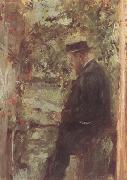 |
Wilhelm Leibl
|
|
German Realist Painter, 1844-1900
German painter, draughtsman and etcher. In 1861 he abandoned his apprenticeship as a locksmith in order to train as a precision instrument maker, though a month or so later he decided to train as an artist, at first under the Cologne history painter and writer Hermann Becker (1817-85). In 1863 he moved to Munich; he studied there from March 1864, at the Akademie der Bildenden K?nste, initially under Philipp von Foltz and Alexander Straehuber, drawing from plaster casts, and later in Hermann Ansch?tz's painting class. Here, Arthur von Ramberg (1819-75) stimulated Leibl's sensitivity to colour; and Karl Theodor von Piloty encouraged him to observe reality and incorporate its lessons boldly into compositions on historical themes. From the start, however, Leibl tended to think of his pictures in terms of form rather than content. While at the Akademie he first reached a standard of excellence with his draughtmanship, which is notable for its directness and objectivity. As an artist, Leibl's early works were not especially promising. However, as occurred throughout his career, a long period of mediocrity was crowned by an unexpected masterpiece, such as his portrait drawing of Aunt Josepha (c. 1864; Cologne, Wallraf-Richartz-Mus.). This is particularly striking for Leibl's use of the hands to add to the expression of the sitter's character and mood, a device he was to use frequently in later work. In Munich, Leibl supplemented the teaching of the Akademie by studying the works of the Old Masters in the Alte Pinakothek: he paid particular attention to painters of the Baroque period such as van Dyck, Cornelis de Vos and Rubens, and also to other great masters of portraiture such as Frans Hals and Vel?zquez. The presentation of the subject found in such works is reflected in Leibl's portrait of Frau Gedon (1869; Munich, Neue Pin.). When the work was shown at the Grossen Internationale Kunstausstellung in Munich in 1869 it was singled out as the best oil painting of the exhibition by Gustave Courbet and, as a result, Leibl was honoured with an invitation to Paris, where he arrived on 13 November 1869. |
|
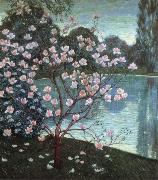 |
wilhelm list
|
|
Siegmund Wilhelm List (May 14, 1880 ?C August 17, 1971), was a German field marshal during World War II, and at the start of the war was based in Slovakia in command of the Fourteenth Army.
List was born in Oberkirchberg near Ulm, Weerttemberg, Germany in 1880 and entered the Bavarian Army in 1898 as a cadet. In 1900 he was promoted to Lieutenant and in 1913 he joined the general staff as a Hauptmann. He served as a staff officer in World War I.
After the war List stayed in the Reichswehr and most of his assignments were as an administrator. In 1927 he was promoted to Oberst, in 1930 he was promoted to General-Major and in 1932 he was promoted to General-Leutnant. In 1938 after the Anschluss of Austria he was made responsible for integrating the Bundesheer into the Wehrmacht.
During 1939 List commanded the German 14th Army in the invasion of Poland. From 1939 to 1941 he commanded the German 12th Army in France and Greece. During 1941 he was Commander-in-Chief South-East. In July 1942 he was Commander-in-Chief of Army Group A on the Eastern Front in the Soviet Union.
|
|
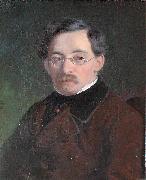 |
Wilhelm Marstrand
|
|
(24 December 1810 - 25 March 1873), painter and illustrator, was born in Copenhagen, Denmark to Nicolai Jacob Marstrand, instrument maker and inventor, and Petra Othilia Smith. Marstrand is one of the most renowned artists belonging to the Golden Age of Danish Painting.
Marstrand studied at Copenhagen's Metropolitan School (Metropolitanskolen), but had little interest in books, and left around 16 years of age. Christoffer Wilhelm Eckersberg, painter and professor at the Royal Danish Academy of Art (Det Kongelige Danske Kunstakademi) in Copenhagen, was a close friend of Wilhelm's father, and it was to all appearance Eckersberg who recommended an artistic career for young Wilhelm. Wilhelm had already shown artistic talent, tackling difficult subjects such as group scenes with many figures and complicated composition.
At 16 years of age Marstrand thus began his studies at the Academy under Eckersberg, attending the school from 1826 to 1833. Although his interests had a firm hold in genre themes - depiction of the daily life he observed around him in Copenhagen's streets, especially middle class society - he would soon reach for the pinnacle of Academic acceptability: the history painting.
History painting displayed what was grand - classical themes from mythology and history, rather than daily life. The traditions, and the taste of traditional art critics, strongly favored it. It was therefore something to strive for, in spite of Marstrand's equal skill at depicting more modest themes, and of the enjoyment he had in portraying the crowds, the diversions of the city, and the humor and story behind the hustle and bustle. Marstrand's creative production would, through many paintings and illustrations made not only during the 1830s but throughout his life, never abandon this inclination toward displaying the simple life of his times.
At the same time Christian Waagepetersen, wine merchant to the Danish court and supporter of the arts, also became an important patron for Marstrand during this early period. His painting "A musical evening party" (Et musikalsk aftenselskab) (1834), depicts such an occasion at the home of Waagepetersen, and was an important transition painting for Marstrand.
Despite an unmistakably growing recognition, Marstrand never received the Academy's gold medal. This medal was coveted not only for its great prestige, but also because it came with a travel stipend for furthering the laureate's artistic training. Marstrand's attempts at winning the medal were unsuccessful both in 1833 with his neoclassical "Flight to Egypt" (Flugten til Ægypten) and in 1835 with "Odysseus and Nausikaa". This was a disappointment, as he had won both available silver medals in 1833.
|
|
|
|
|
|
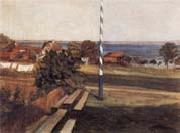 |
Wilhelm Trubner
|
|
German, 1851-1917
was a German realist painter of the circle of Wilhelm Leibl. Trubner was born in Heidelberg and had early training as a goldsmith. In 1867 he met classicist painter Anselm Feuerbach who encouraged him to study painting, and he began studies in Karlsruhe under Fedor Dietz. The next year saw him studying at the Kunstacademie in Munich, where he was to be greatly impressed by an international exhibition of paintings by Leibl and Gustave Courbet. Courbet visited Munich in 1869, not only exhibiting his work but demonstrating his alla prima method of working quickly from nature in public performances. This had an immediate impact on many of the city's young artists, who found Courbet's approach an invigorating alternative to the shopworn academic tradition. The early 1870s were a period of discovery for Tr??bner. He travelled to Italy, Holland and Belgium, and in Paris encountered the art of Manet, whose influence can be seen in the spontaneous yet restrained style of Trubner's portraits and landscapes. During this period he also made the acquaintance of Carl Schuch, Albert Lang and Hans Thoma, German painters who, like Trubner, greatly admired the unsentimental realism of Wilhelm Leibl. This group of artists came to be known as the "Leibl circle". He published writings on art theory in 1892 and 1898, which express above all the idea that "beauty must lie in the painting itself, not in the subject". By urging the viewer to discover beauty in a painting's formal values, its colors, proportions, and surface, Trubner advanced a philosophy of "art for art's sake". |
|
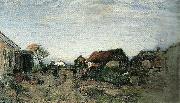 |
wilhelm von gegerfelt
|
|
född 9 november 1844 i Göteborg, död 1920, målare, son till arkitekten Victor von Gegerfelt.
von Gegerfelt studerade 1861-63 vid konstakademien i Köpenhamn, 1864-67 vid akademien i Stockholm och 1867-72 i D??sseldorf, varefter han överflyttade till Paris. Där arbetade han sig till en helt ny teknik och blev jämte Alfred Wahlberg den förste svenske representanten för det moderna stämningslandskapet. Han gjorde studieresor till Frankrikes nordkust, till hemlandet och till Italien, målade skymning över Venedigs kajer, månsken över lagunerna, kritklippor vid Engelska kanalen i gråstämning, svenska sommarnätter, allt med elegant pensel, smekande färg och livligt föredrag. Gegerfelt är representerad på Nationalmuseum av Stormen (akvarell, motiv från Dalarna, inköpt 1886) och Strand på Hallands Väderö (i olja, 1893) samt på Göteborgs konstmuseum av Strandgata i Venezia (1884), oljemålningen Vinterafton på Hallands Väderö (1893) samt akvarellen Fjällbacka. |
|
|

